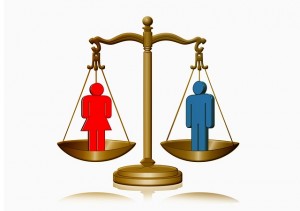Addressing Inequality at the Top: Parity Relates to Pay
Amidst President Obama’s recent executive action strengthening the enforcement of equal pay laws and discussion inspired by Equal Pay Day (April 8), the White House Office of Personnel Management has released a report—Governmentwide Strategy on Advancing Pay Equity in the Federal Government—highlighting a nuanced reality.
 OPM’s research uncovered encouraging news: the wage gap between male and female federal employees “has dramatically shrunk.” From 1992 to 2012, this gap plummeted from about 30 percent (a woman made 70 cents for every dollar a man made) to 13 percent (87 cents to the dollar) for federal, white-collar positions. Yet, OPM and the Washington Post indicate these statistics only expose one frame of a more complex picture. A closer look reveals a major problem: women are still few and far between in the upper echelons of government.
OPM’s research uncovered encouraging news: the wage gap between male and female federal employees “has dramatically shrunk.” From 1992 to 2012, this gap plummeted from about 30 percent (a woman made 70 cents for every dollar a man made) to 13 percent (87 cents to the dollar) for federal, white-collar positions. Yet, OPM and the Washington Post indicate these statistics only expose one frame of a more complex picture. A closer look reveals a major problem: women are still few and far between in the upper echelons of government.
Women hold just about one third of Senior Executive Service (SES) positions, and not many more of the highest General Schedule slots. Female underrepresentation at the top is not limited to the federal government, though.
Women constitute only 4.6 percent of CEOs, 23 percent of equity partners in law firms, and 23 percent of all federal judgeships. As for legislative positions, the United States is ranked 84th in the world for women’s representation, with women holding only 18.3 percent of the U.S. House and 20 percent of the U.S. Senate. Turning to the state legislatures, women occupy only 24.2 percent of seats. In the media, women own only 5.8 percent of all television stations and 6 percent of radio stations. Overall, women hold just 5 percent of top roles in telecommunications, entertainment, publishing, and advertising. While women comprise the overwhelming majority of the nonprofit workforce, they hold less than half of its CEO and executive director positions.
This leadership landscape need not remain so lopsided. Fortunately, there are ways to address the dearth of women at the top that will help narrow the pay gap and bring greater diversity to executive offices across government, civil service, business, law, media, and entertainment. In her recent blog post, OPM Director Katherine Archuleta reinforces Parity’s convictions that we must build stronger employment and promotion pipelines for women.
Political parties must actively recruit and connect potential candidates to resources and people who can support their professional development. By developing long-term mentoring relationships, and coaching budding public servants to follow in their footsteps, elected and appointed leaders can help young women gain exposure to and demystify the political process. By identifying, encouraging, and supporting women to take on managerial and executive roles—where the pay rate is near-parity—we can chip away at both the wage and leadership gaps.
In Archuleta’s words, “We won’t be satisfied until women working in federal jobs earn the same as their male counterparts, at every level.” We also won’t be satisfied until political parity is achieved in our nation’s highest public offices. We need women to draw on 100% of the talent pool, contribute a new style of leadership, raise public trust in government, and influence policy outcomes. And yes, we need them at the top.
